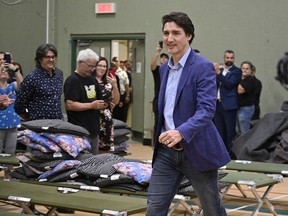Get the latest from Lorrie Goldstein straight to your inbox

Article content
While the Trudeau government has tripled the amount of money it spends on Indigenous issues from $11 billion annually in 2015 to more than $32 billion earmarked for 2025, it doesn’t appear to be improving the lives of on-reserve Indigenous people, according to a new study by the fiscally conservative Fraser Institute.
Advertisement 2
Article content
Recommended Videos
In “An Avalanche of Money: The Liberal Government’s Policies Toward First Nations,” author Tom Flanagan argues the most effective program at improving the lives of Indigenous people on reserves has been the Liberals’ Canada Child Benefit introduced by Prime Minister Justin Trudeau in 2016 — a universal program that helps all Canadian families, except for those in the highest income brackets.
That raises the question of where all of the other federal money being spent specifically on Indigenous issues is going, Flanagan said.
He notes that from 2016 to 2021, Statistics Canada’s Community Well-Being Index, which measures the standard of living of communities across the country on the basis of education, employment, income and housing, reported that the average gap between First Nations families living on reserves and other Canadian families was reduced from 19.1 points to 16.3.
Article content
Advertisement 3
Article content
He argues this occurred mainly due to the increased income the CCB gives to First Nations families living on reserves because they have more children and lower incomes on average than other Canadians.
The CCB allocates up to $7,787 annually per child under age six and up to $6,570 annually for children age six to 17.
These amounts start to be reduced when a family’s adjusted annual net income is over $36,502 and the Trudeau government says it has lifted hundreds of thousands of children out of poverty.
But it also raises the question of where all the money from other federal programs targeted specifically to Indigenous people is going.
For example, the Trudeau government has repeatedly broken its 2015 promise to end all drinking water advisories on First Nations reserves by March 2021.
Advertisement 4
Article content
According to the latest data available, while the federal government has lifted 147 long-term advisories since 2015, 31 remain in effect in 29 Indigenous communities.
Auditor General Karen Hogan reported in 2021 that “Indigenous Services Canada did not provide adequate support to First Nations communities so that they have access to safe drinking water” predicting the problem could continue on some reserves for years
In addition to tripling annual spending on Indigenous issues to $32 billion from 2015 to 2025, Flanagan noted the Trudeau government is settling many Indigenous class action lawsuits without litigation, resulting in increasing liabilities for taxpayers.
Recommended from Editorial
Advertisement 5
Article content
Parliamentary Budget Officer Yves Giroux reported in July that the federal government’s estimate of all of its outstanding contingent legal liabilities, as of March 31, 2023, was $76 billion, growing by about 30% annually since 2016, a large portion of this attributed to Indigenous claims.
Giroux noted that in 2023, the Trudeau government recorded expenses of $26 billion related to Indigenous litigation in that year alone, and advised parliamentarians to seek better information from the government on how these expenditures impact the government’s budgetary balance.
Meanwhile, Flanagan said, specific legal claims with Indigenous groups are being settled by the Trudeau government at a rate four times higher than that of the previous Progressive Conservative government, leading to a significant transfer of land and money to First Nations.
“If policy makers in Ottawa want to help Indigenous people, they should look closely at what types of spending policies produce the most tangible benefits,” Flanagan said.
RECOMMENDED VIDEO
Article content




Comments